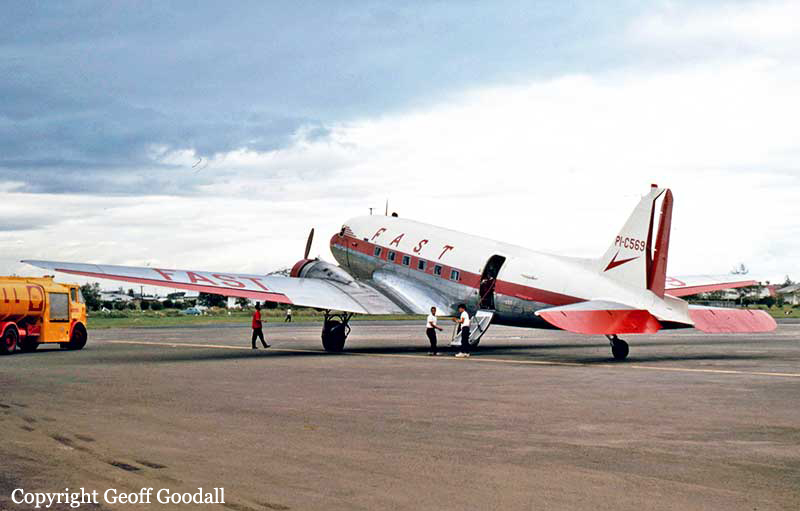Country
code
Aklan
Crash of a Xian MA60 in Caticlan
Date & Time:
Jun 25, 2009 at 0755 LT
Registration:
RP-C8892
Survivors:
Yes
Schedule:
Manila - Caticlan
MSN:
07 03
YOM:
2008
Flight number:
EZD863
Crew on board:
4
Crew fatalities:
Pax on board:
55
Pax fatalities:
Other fatalities:
Total fatalities:
0
Circumstances:
Following an uneventful flight from Manila, the crew started the descent to Caticlan Airport and was informed that runway 06 was in use due to the wind component. For unknown reasons, the captain decided to land on runway 24. The approach was too long and the aircraft landed too far down the runway, about 950 metres past the runway threshold. Unable to stop within the remaining distance, it overran and came to rest in a grassy area against the perimeter fence. All 59 occupants escaped uninjured while the aircraft was damaged beyond repair.
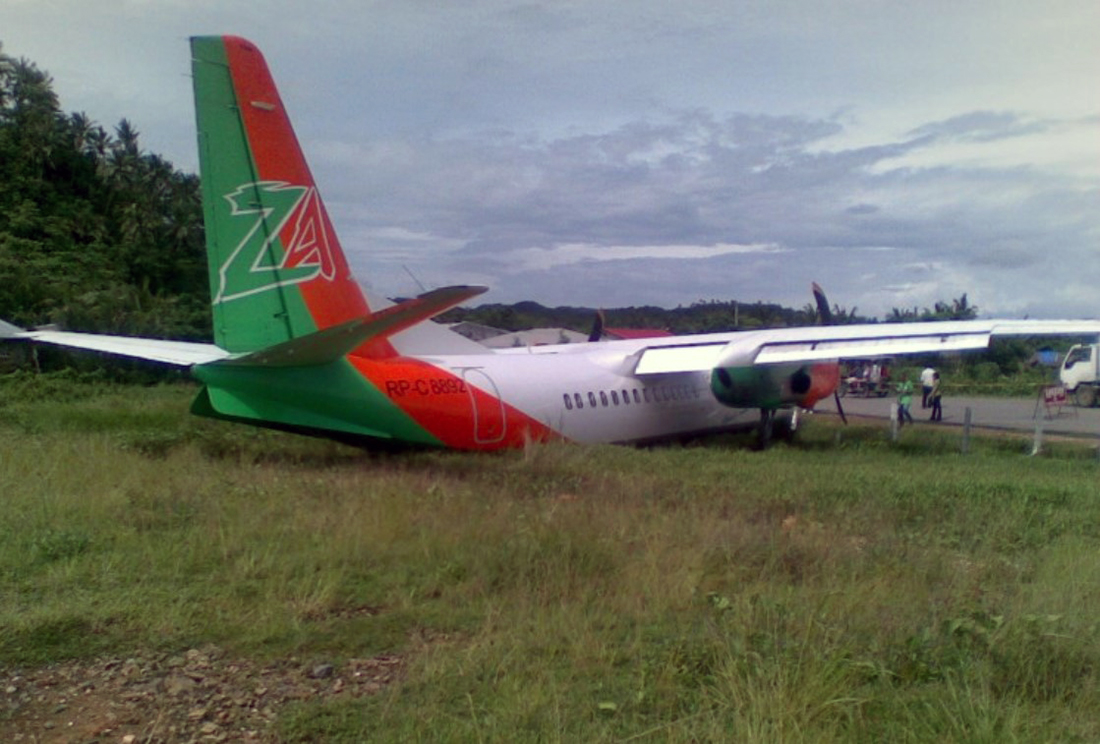
Crash of a Xian MA60 in Caticlan
Date & Time:
Jan 11, 2009 at 0658 LT
Registration:
RP-C8893
Survivors:
Yes
Schedule:
Manila - Caticlan
MSN:
07 04
YOM:
2008
Flight number:
EZD865
Crew on board:
5
Crew fatalities:
Pax on board:
22
Pax fatalities:
Other fatalities:
Total fatalities:
0
Captain / Total hours on type:
500.00
Circumstances:
On or about 0613LT 11 January 2009, flight 6K865 RP-C8893 departed NAIA (RPLL) for Caticlan Airport (RPVE) with 22 passengers and 5 crew members on board. The flight was uneventful until a go-around was initiated during the first approach, A second attempt to land was made which ended with the aircraft undershooting the runway. After the first touchdown the aircraft bounce and landed on the runway and veered to the left side of the runway due to the left landing gear failure upon the contact with the embankment before the road at the end of the runway. The aircraft settled down at the concrete wall of the ramp facing the passenger lounge of the Zest Air. Three (3) passengers suffered serious injuries, and 19 passengers with minor one, the crew member escape injuries except the Captain suffering slight injury. The aircraft was damaged beyond economical repair.
Probable cause:
- The captain’s low level of experience (2,675 hours) and less than 500 hours PIC.
- The critical runway conditions (950 M and gusty wind conditions No PAPI).
- The absence of crew coordination (monitoring and CRM).
- The critical runway conditions (950 M and gusty wind conditions No PAPI).
- The absence of crew coordination (monitoring and CRM).
Final Report:
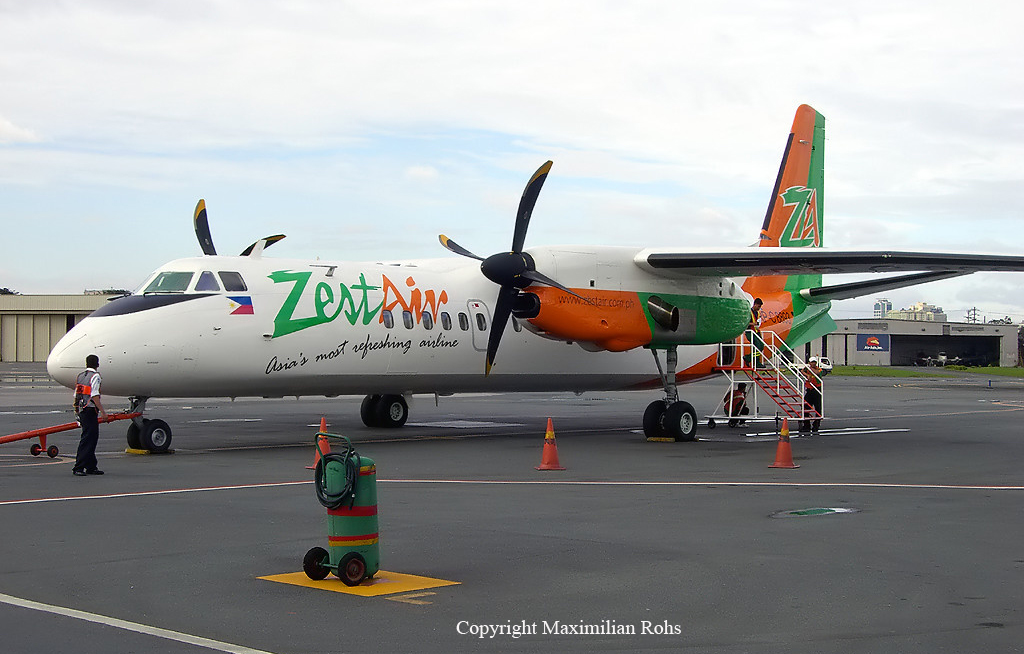
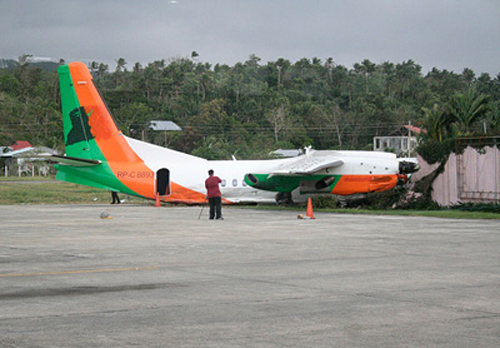
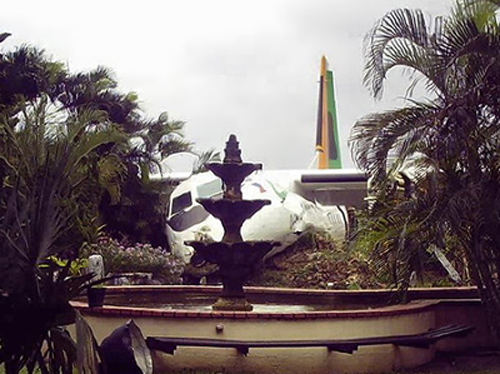
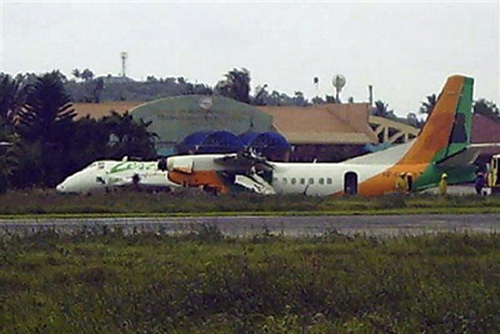
Crash of a Yakovlev Yak-40 in Caticlan
Date & Time:
Nov 2, 2006 at 0745 LT
Registration:
RP-C2695
Survivors:
Yes
Schedule:
Manila - Caticlan
MSN:
9 52 20 41
YOM:
1975
Crew on board:
3
Crew fatalities:
Pax on board:
0
Pax fatalities:
Other fatalities:
Total fatalities:
0
Circumstances:
The crew departed Manila-Ninoy Aquino Airport on a positioning flight to Caticlan to carry a group of tourists. After touchdown, the left tyre burst. The aircraft deviated to the left then veered off runway and contacted a grassy area. The left main gear collapsed and the aircraft came to rest. All three crew members escaped uninjured while the aircraft was damaged beyond repair.
Probable cause:
Loss of control after a tyre burst on landing.
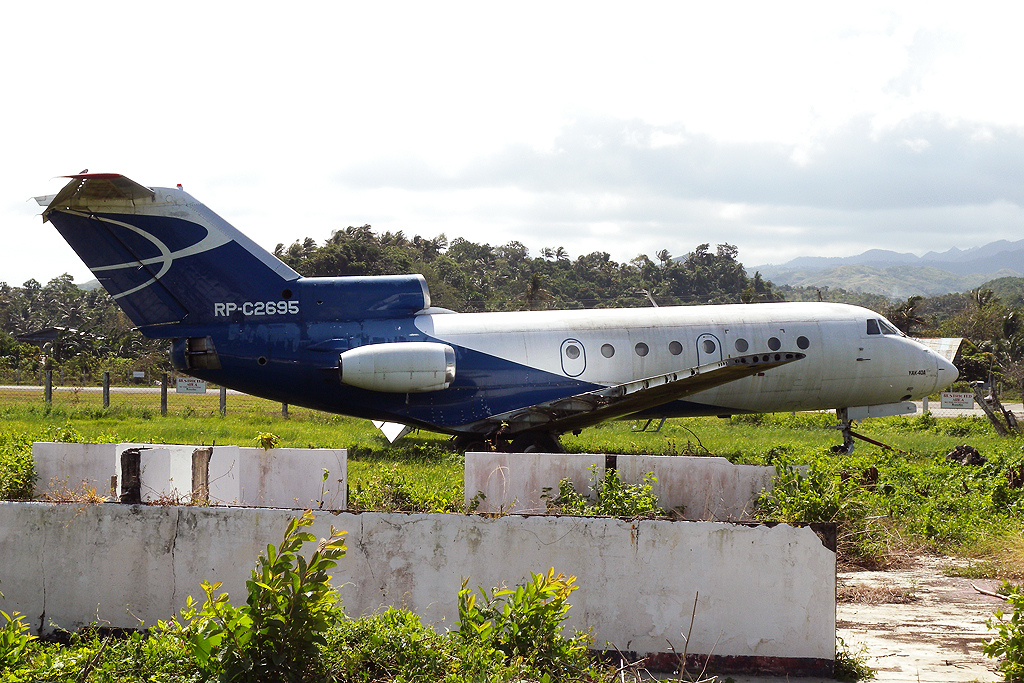
Crash of a Yakovlev Yak-40 in Caticlan
Date & Time:
Jul 19, 2005 at 0958 LT
Registration:
RP-C2803
Survivors:
Yes
Schedule:
Manila - Caticlan
MSN:
9 43 05 37
YOM:
1975
Flight number:
ISL210
Crew on board:
3
Crew fatalities:
Pax on board:
20
Pax fatalities:
Other fatalities:
Total fatalities:
0
Circumstances:
On final approach to Caticlan-Malay Airport, the three engine aircraft was too low and struck the ground short of runway 06. A tyre burst as it struck the raised lip of the runway. When removing the airplane from the runway the undercarriage collapsed. The aircraft came to rest after a course of few dozen metres. All 23 occupants escaped uninjured and the aircraft was damaged beyond repair. Caticlan Airport has a concrete runway of 950 metres long.
Probable cause:
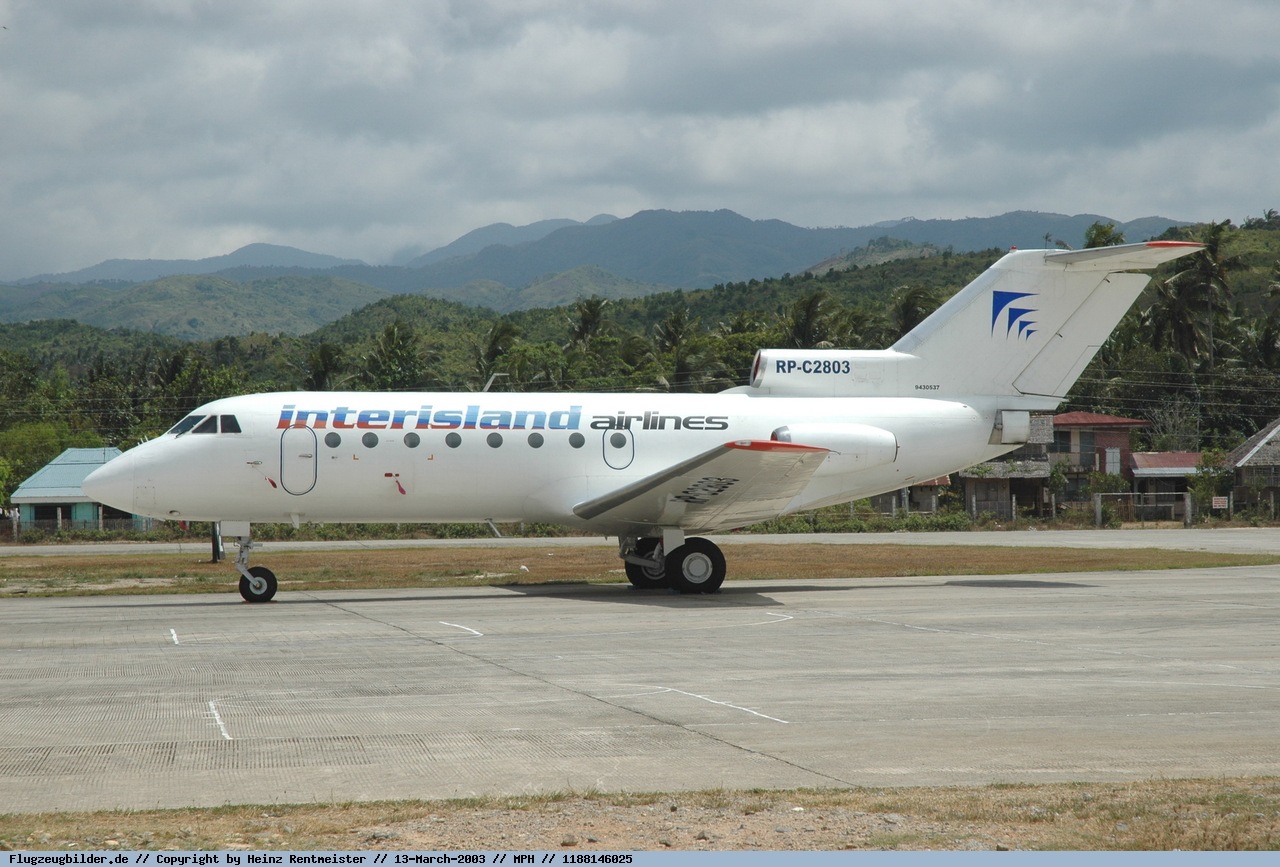
Crash of a Fairchild F27 off Ibajay: 14 killed
Date & Time:
Mar 8, 1968 at 1918 LT
Registration:
PI-C871
Survivors:
No
Schedule:
Manila - Mactan
MSN:
19
YOM:
1958
Flight number:
UM507
Crew on board:
4
Crew fatalities:
Pax on board:
10
Pax fatalities:
Other fatalities:
Total fatalities:
14
Captain / Total hours on type:
158.00
Copilot / Total hours on type:
92
Aircraft flight hours:
21194
Circumstances:
Flight UM507 was a scheduled domestic flight from Manila International Airport to Lapu-Lapu/Mactan International Airport. Before departure the pilot was briefed by the Air Manila dispatcher on the existence of a cold front across the route and was provided with an en-route weather forecast valid from 1200 to 2400 hours which mentioned "Isolated thunderstorm over Eastern Visayas and generally fair elsewhere". No information regarding thunderstorms on the route was given to the pilot. The flight took off from Manila at 1814 hours and was cleared to Mactan at FL 130 by the ATC, via Track 5, Amber 4 and Amber 1. The flight plan proposed an airspeed of 210 kt and an estimated time en route of 1 hour 45 minutes. Normal radio contact was maintained at all time between the flight and the air traffic services. At 1908 hours the flight reported over Romblon at FL 130, estimating Mactan at 1954 hours. This was the last message from the aircraft. Several residents of Ibajay, a coastal town in Aklan, stated that at approximately 1918 hours they had heard a sound similar to that of an aircraft flying at high altitude in a southeast direction along the coastline. They then heard several loud explosions and saw fireballs falling into the sea. They all agreed that the initial fire- ball they saw could not have been the result of a prolonged fire, but rather a small fire which rapidly developed into a large orange-yellow-red ball and then disappeared. After a few moments, smaller fireballs emerged from the large one, some dying out before reaching the sea, some reaching the sea and developing into a large fire. At the same time a large object resembling an airplane was seen to emerge from thick clouds and fall into the sea followed by a trail of smaller objects. Approximately one hour later two bodies were recovered from approximately 2 km offshore of Bo. Colong-Colong, Ibajay, Aklan.
Probable cause:
The Board determined that the probable cause of the accident was an in-flight structural failure due to air loads exceeding the design strength, while flying in a thunderstorm cell. It was also determined the following:
- The flight transmitted its last position report over Romblon at 1908 hours, approximately 10 minutes before the accident, and did not report any operating difficulty,
- The aircraft disintegrated at a high altitude with considerable speed,
- None of the aircraft parts recovered showed evidence of fatigue, or explosion due to combustible gas mixtures, or concentrated explosives such as dynamite,
- Over the area at approximately the time of the accident, there were thunderstorm cells and two other flights deviated and avoided the area,
- The crash location was about 10 NM right of the assigned airway,
- Only two bodies were recovered; the other occupants and the rest of the wreckage could not be recovered due to the depth of the sea in the general area of the accident and their exact location is unknown.
- The flight transmitted its last position report over Romblon at 1908 hours, approximately 10 minutes before the accident, and did not report any operating difficulty,
- The aircraft disintegrated at a high altitude with considerable speed,
- None of the aircraft parts recovered showed evidence of fatigue, or explosion due to combustible gas mixtures, or concentrated explosives such as dynamite,
- Over the area at approximately the time of the accident, there were thunderstorm cells and two other flights deviated and avoided the area,
- The crash location was about 10 NM right of the assigned airway,
- Only two bodies were recovered; the other occupants and the rest of the wreckage could not be recovered due to the depth of the sea in the general area of the accident and their exact location is unknown.
Final Report:
Crash of a Douglas C-47A near Libacao: 37 killed
Date & Time:
Jul 25, 1965 at 0740 LT
Registration:
777
Survivors:
No
Schedule:
Nichols - San Jose Buenavista
MSN:
20243
YOM:
1944
Crew on board:
7
Crew fatalities:
Pax on board:
30
Pax fatalities:
Other fatalities:
Total fatalities:
37
Circumstances:
The airplane departed Nichols AFB in the early morning, bound for San Jose Buenavista with 7 crew members and 30 passengers, among them civilians. While cruising at an altitude of 6,000 feet in poor weather conditions, the airplane struck the slope of Mt Madiac located 95 km northeast of San Jose Buenavista. SAR operations were conducted and the wreckage was found three days later in an isolated area, about 300 meters below the summit. The aircraft was destroyed and all 37 occupants have been killed. At the time of the accident, weather conditions were poor with low clouds and a visibility limited to few hundred meters. There were some gusty winds up to 40 knots at the time of the accident, which caused the aircraft to deviate from the prescribed route.
Probable cause:
Controlled flight into terrain.
Crash of a Douglas C-47A-90-DL in Numancia: 1 killed
Date & Time:
Dec 21, 1964 at 1840 LT
Registration:
PI-C569
Survivors:
Yes
Schedule:
Kalibo – Manila
MSN:
20396
YOM:
1944
Crew on board:
3
Crew fatalities:
Pax on board:
36
Pax fatalities:
Other fatalities:
Total fatalities:
1
Captain / Total hours on type:
4000.00
Circumstances:
The aircraft was on a non-scheduled flight from Kalibo to Manila. It took off from runway 05 at 1740 hours Philippine local time and the co-pilot testified that the take-off was normal and all engine instruments were indicating within normal operating range throughout the take-off and during the initial climb. He further testified that approximately 20 minutes after take-off, severe vibration and misses, decreasing oil pressure and increasing oil temperature of the left-hand engine, were noted as the airplane was climbing to 2,200 feet. The left-hand engine was shut down, its propeller feathered, and shortly after the pilot-in-command reversed course and descended with the intention of landing at either Kalibo or Roxas Airports. Neither airport was rated for night operations. The flight proceeded to Kalibo. Precipitation was encountered on the way and the visibility was so poor that the crew failed to make visual contact with Kalibo Airport. At 1823 hours, a climb to 2,000 feet was attempted to clear the terrain on the way to Bacolod Airport, the nearest airport available for night operations. However, with METO power on the remaining engine, the aircraft not only failed to climb but also failed to maintain altitude with the airspeed decreasing to 80 mph. Several attempts to climb were made but were discontinued due to pre-stall warning. At 1835 hours with 500 feet altitude, the pilot-in-command decided to ditch and warned the passengers accordingly. At 1839 hours, the ditching was attempted but the airplane collided with coconut trees located approximately 500 feet from the Barrio Camansi Norte shoreline and crashed on the muddy bed of an abandoned fishpond on a heading of 300°, approximately 160 feet from the point of initial collision. The accident occurred around 1840 hours.
Probable cause:
The Board determined that the probable cause of the accident was failure to maintain safe single-engine speed and altitude following failure of the left engine. The precipitation and poor visibility prevailing at the time of the accident over Kalibo and its vicinity and the failure on the part of the maintenance personnel to take action to correct discrepancies logged in the aircraft logbook, individually or collectively contributed to the cause of the accident.
Final Report:
